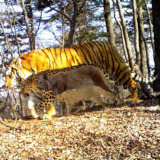The Dhole and the Tiger: A Follow Up · 12:51am Nov 17th, 2021
Over two years ago, you might remember that I wrote a blog post about the old historical stories of dholes killing tigers.
I am not convinced those stories are real. That was over two years ago. Now, over two years later, a new scientific study was done on the interactions between tigers and dholes in India. The scientists looked at two parts of India: Tadoba-Andhari Tiger Reserve (TATR) and the Navagaeon-Nagzira Tiger Reserve (NNTR). Both are in Central India and are comparable landscapes. When comparing the two areas it was found that prey densities were similar in both places, but it looks like gaur populations were higher in NNTR. The tiger population at TATR is higher than in NNTR, but dhole packs are smaller in TATR than in NNTR. In TATR they averaged 6 individuals and in NNTR they averaged 16 individuals. Quite a big difference. The scientists determined the reason for it was because, in TATR, dholes experience higher tiger predation.
They then did a distribution-wide assessment and found that dhole pack sizes increase with higher prey populations, but pack sizes decline when tiger populations are higher, and apparently, the effect tigers have on pack sizes is greater than the effect that prey populations have on them. Tigers kill dholes to eliminate perceived competition, and dholes prefer being in smaller packs in places with lots of tigers for two reasons.
1. Tigers kill all types of dholes. The death of breeders can lead to a lower reproductive rate and destabilization of the pack. If a tiger kills one or a few other adults in the pack, that means fewer members hunting and a lower hunting success rate, it also means fewer adults to care for the pups and less food given to them due to a lower success rate. Tigers killing litters of pups also leads to a lower reproductive rate.
2. When hunting, dholes can kill animals up to 10 times their size. However, they prefer hunting animals around 50 kg or less. In places with higher tiger populations, they prefer hunting smaller animals that way they can eat more of a carcass before a tiger shows up to steal it.
What relevance does this have for the old stories?
Simple, back then there were way more wild areas than there are currently, meaning not only more dholes and prey animals, but also more tigers, meaning more tigers killing dholes and taking carcasses from them. You might be able to argue that the intense tiger trophy hunting in India would've led to larger dhole packs but even then, one has to consider the bounty that was put on dholes and the intense hunting of those animals which would've also had an impact on pack sizes.
Speaking of those times, there is something interesting I learned earlier this year. The big game hunters (if you can even call them that) would hire local poor people to act as trackers, beaters, and guides. In return, these people were given some food and cash. Dholes weren't attractive trophies, and if people got food and money from guys hunting animals like deer, now the dholes may have been seen as a pest. Making up stories about them attacking people wouldn't work since dholes don't attack people. But making up stories about them killing tigers might've been the next best thing, and now the dholes would seem voracious and cruel. Local hunters, as mentioned before, were paid big bounties for killing dholes so I don't think it was impossible for them to make up stories of dholes killing tigers to make them seem bloodthirsty to justify killing them off.
The study itself is here: https://onlinelibrary.wiley.com/doi/full/10.1002/ece3.7380


